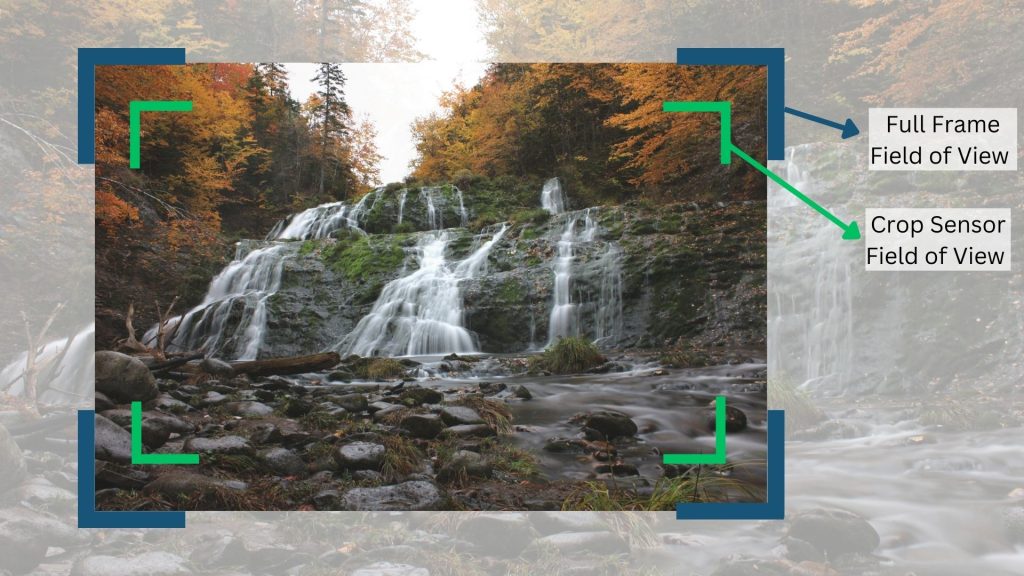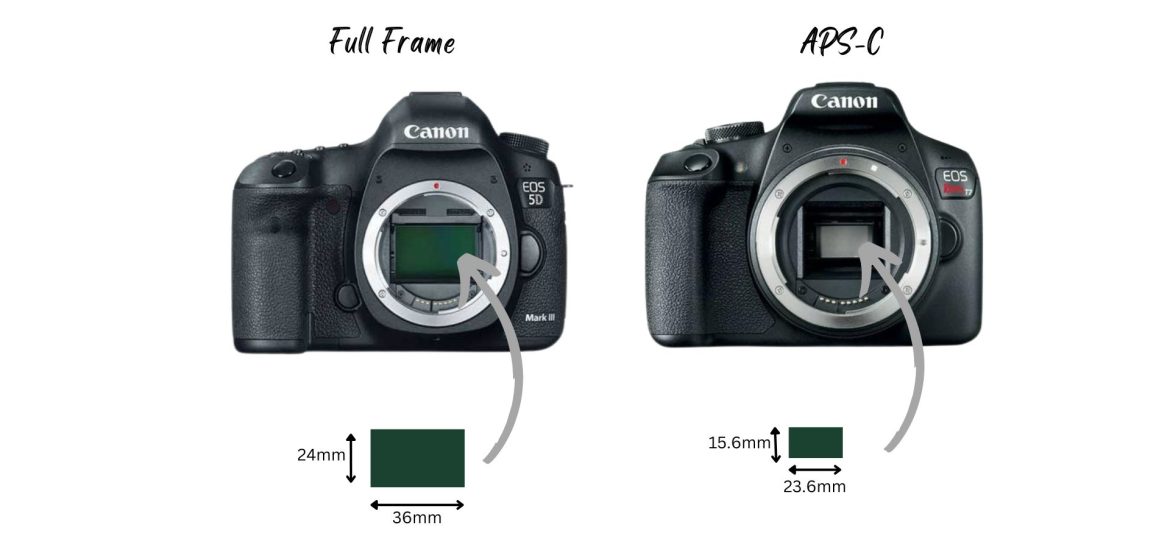Visit Rentovault to find adventure and photography
gear rentals from your neighbours.
As a beginner photographer, choosing the right camera can be overwhelming, with various options available in the market. Two commonly discussed terms in the photography world are “crop sensor” and “full frame” cameras. In this blog post, we will delve into the differences between these two types of cameras, including their advantages and limitations, and help you make an informed decision for your photography needs.
Understanding Crop Sensor Cameras:
Crop sensor cameras, also known as APS-C cameras, have a smaller sensor size compared to full frame cameras. The crop factor refers to how much smaller the sensor is in relation to a full frame sensor. Popular camera brands such as Canon, Sony, Nikon, and Fujifilm offer crop sensor cameras with different crop factors, ranging from 1.5x to 1.6x.
One advantage of crop sensor cameras for beginner photographers is their affordability. They generally come with a lower price tag compared to full frame cameras, making them a budget-friendly option. Additionally, crop sensor cameras are usually smaller and lighter, making them more portable and convenient for outdoor photography adventures.
Exploring Full Frame Cameras:
Full frame cameras, on the other hand, have a larger sensor size that is equivalent to the size of their predecessors – 35mm film frame. This larger sensor size results in better image quality, improved low-light performance, and increased dynamic range compared to crop sensor cameras.
Full frame cameras are often favored by professional photographers for their superior image quality and versatility in various photography genres. They typically offer a wider field of view and more control over depth of field, which can be advantageous in portrait, landscape, and low-light photography. We take a deeper look at these in the sections below.
However, full frame cameras tend to be more expensive and heavier compared to crop sensor cameras, which can be a consideration for beginner photographers with limited budgets or those who prioritize portability.
Full Frame vs. Crop Sensor Image Quality:
One of the significant differences between full frame and crop sensor cameras is image quality. Due to their larger sensor size, full frame cameras generally produce higher image quality with better dynamic range, lower noise at higher ISOs, and improved low-light performance compared to crop sensor cameras. This is because a larger sensor can capture more light, resulting in richer and more detailed images.
However, it’s important to note that advancements in technology have narrowed the image quality gap between full frame and crop sensor cameras in recent years. Modern crop sensor cameras now offer impressive image quality that is more than sufficient for most beginner photographers, especially for online sharing or smaller prints.
Why Full Frame produces better quality images
- Higher Signal-to-Noise Ratio (SNR): Image sensors capture light as photons, and these photons are converted into electrical signals. However, image sensors also generate a certain amount of random electrical noise, which can degrade image quality by introducing unwanted artifacts, such as grain or speckles. Larger image sensors have more surface area to capture light, which results in a higher number of photons hitting the sensor. This leads to a higher signal-to-noise ratio (SNR), meaning that the signal (i.e., the light captured) is stronger relative to the noise (i.e., the random electrical noise generated by the sensor). As a result, images captured with larger sensors tend to have less noise and appear cleaner and more detailed.
- Better Dynamic Range: Dynamic range refers to the ability of an image sensor to capture a wide range of brightness levels, from the darkest shadows to the brightest highlights, without losing detail. Larger image sensors typically have a higher dynamic range compared to smaller ones. This is because larger sensors can capture more light and have a higher capacity to store a wider range of brightness values. As a result, images taken with larger sensors have more details in both shadows and highlights, and display a greater tonal range, resulting in more visually appealing and realistic images.
- Improved Low-Light Performance: In low-light conditions, larger image sensors have a significant advantage over smaller ones. As they capture more light due to their larger surface area, they are able to produce brighter and cleaner images with less noise in low-light situations. This is particularly important for low-light photography, such as night photography or indoor photography without a flash, where larger sensors can deliver superior image quality with less noise and better color accuracy.
- Shallower Depth of Field: Explained in details below.
- Better Overall Image Quality: When you combine all the factors mentioned above, including higher SNR, improved dynamic range, better low-light performance, and shallower depth of field, larger image sensors ultimately contribute to better overall image quality. Images captured with larger sensors tend to have more detail, less noise, greater tonal range, and better color accuracy, resulting in sharper, more vibrant, and more visually appealing images.
Full Frame vs. Crop Sensor Bokeh:
Bokeh, the aesthetically pleasing blur in the out-of-focus areas of an image, is often a desired effect in photography, particularly in portraits and close-up shots. Full frame cameras with their larger sensor size generally produce a shallower depth of field, which can result in smoother and creamier bokeh compared to crop sensor cameras.
Why Full Frame has shallower depth of field
The depth of field is mainly influenced by 2 factors:
- Lens Aperture: Simply put, the wider the aperture, the shallower the depth of field. However, this is completely up to the lens and the camera body has no effect on it.
- Angle of View: The angle of view, or the field of view, is the extent of the scene that is visible through the lens. Larger image sensors have a narrower angle of view compared to smaller sensors when using lenses with the same focal length. This often necessitates the use of longer focal lengths to maintain the same field of view as a smaller sensor. As focal length increases, depth of field decreases, creating that desirable shallow effect where the subject is in sharp focus while the background is beautifully blurred. Another way of thinking about this is that because a narrower angle of view magnifies the subject, it reduces the depth of field.
Here’s an example to illustrate this concept:
Let’s consider a portrait shot taken with two different cameras, one with a smaller APS-C sensor and another with a larger full-frame sensor, using the same lens with an aperture of f/1.8. The subject is positioned at the same distance from the camera in both shots, and the background is at a similar distance behind the subject.
Let’s say for our desired composition with the smaller APS-C sensor, we use a focal length of 70mm. Since the larger full-frame sensor has a larger angle of view, we will have to use a larger focal length (say 85mm), to get the same composition. Thus, the full frame camera will give us the shallower depth of field and consequently, the better bokeh for the same photo.
Understanding Crop Factors:
Crop factor is an important factor to consider when using different lenses on crop sensor cameras. The crop factor affects the effective focal length and field of view of lenses, as mentioned earlier. For example, a 50mm lens on a crop sensor camera with a 1.6x crop factor would have an effective focal length of 80mm (50mm x 1.6), which can be advantageous for telephoto or close-up shots.

Different camera brands have different crop factors. For instance, Canon crop sensor cameras typically have a 1.6x crop factor, while Sony, Nikon, and Fujifilm cameras usually have a 1.5x crop factor. It’s essential to be aware of the crop factor of the camera you are using and understand how it affects your lens choices and composition.
Making the Right Choice for Your Photography:
When it comes to choosing between crop sensor and full frame cameras, there is no one-size-fits-all answer. It depends on your specific needs, budget, and photography goals.
If you are just starting out and have a limited budget, a crop sensor camera may be a practical choice. It can offer good image quality, portability, and affordability, making it suitable for various genres of photography, especially if you are primarily shooting outdoors or traveling.
On the other hand, if you are looking for top-notch image quality, better low-light performance, and wider field of view, a full frame camera may be the way to go.
Conclusion:
In conclusion, both crop sensor and full frame cameras have their advantages and limitations. Crop sensor cameras are generally more affordable, smaller, and lighter, making them suitable for beginners or those with budget constraints. Full frame cameras, on the other hand, offer superior image quality, wider field of view, and better low-light performance, but they tend to be more expensive and heavier.
Consider your specific needs, budget, and photography goals when choosing between crop sensor and full frame cameras. If image quality and low-light performance are crucial factors, a full frame camera may be worth the investment. However, if affordability, portability, and versatility are prioritized, a crop sensor camera may be a practical choice.
Ultimately, the best camera for you is the one that meets your needs and helps you achieve your creative vision as a beginner photographer. Happy shooting!

